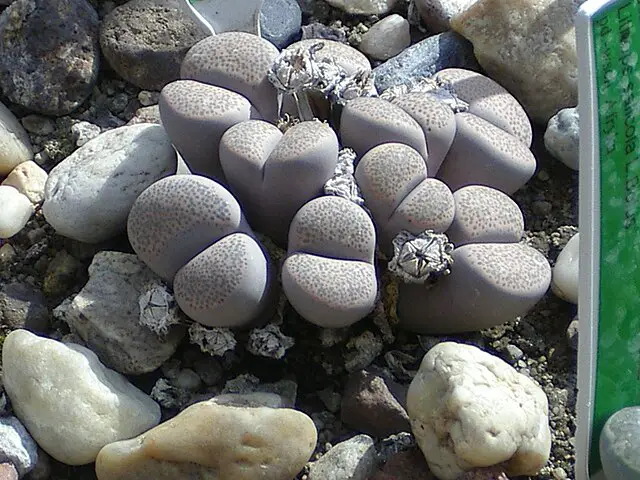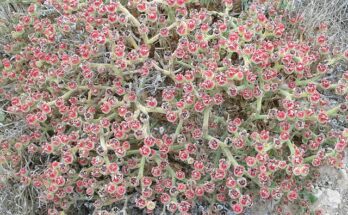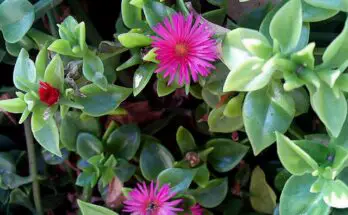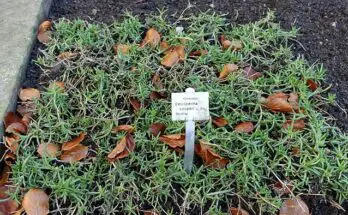Lithops, commonly known as “Living Stones,” are a fascinating group of succulents that mimic stones or pebbles. Originating from the arid regions of Southern Africa, these plants have evolved unique features that make them a subject of intrigue in the succulent world. This article delves into the essentials of Lithops care, covering their peculiar growth habits, ideal environmental conditions, and expert tips for thriving plants.
Understanding Lithops: Nature’s Master of Disguise
Lithops are part of the Aizoaceae family and have developed their stone-like appearance as a survival strategy to avoid predation in their native habitat. Each plant consists of a pair of fleshy leaves, fused together and split by a fissure through which the flowers and new leaves emerge. Their colors and patterns vary widely, resembling the rocks among which they grow.
Lithops Growth Cycle
These fascinating plants have a unique lifecycle that’s closely tied to their adaptation to harsh, arid environments. Their growth cycle can be divided into four key phases, each with distinct characteristics:
- Late Winter to Spring (New Leaf Growth):
- Timeframe: Typically begins in late winter and extends into spring.
- What Happens: As the weather warms, Lithops begin a period of active growth. The plant starts to develop new leaves, which initially appear as small buds between the older leaves.
- Care Tips: This is a time to start lightly watering the plant, encouraging the new leaves’ growth. The old leaves will gradually shrivel as they transfer their nutrients to the new growth.
- Late Spring to Early Summer (Maturity and Flowering):
- Timeframe: Occurs in late spring and can extend into early summer.
- What Happens: The new leaves continue to grow and mature. If the plant is healthy and mature (usually around 3-5 years old), it may produce a flower. Lithops flowers are daisy-like, often yellow or white, and bloom from the center of the leaf pair.
- Care Tips: Continue moderate watering and provide ample sunlight. After flowering, the plant will start transitioning into its first dormant period.
- Summer (First Dormancy):
- Timeframe: Happens during the hot summer months.
- What Happens: Growth slows down or stops. The plant conserves energy and resources to survive the intense heat and dry conditions.
- Care Tips: Reduce watering significantly during this phase. Some growers recommend ceasing watering entirely, as the plant is adapted to survive long dry periods.
- Fall to Early Winter (Second Growth and Second Dormancy):
- Timeframe: Begins in fall and continues into early winter.
- What Happens: Lithops may enter a second growth phase, where the old leaves are fully absorbed by the new leaves, or it may go directly into its second dormancy.
- Care Tips: Resume light watering if the plant shows signs of new growth. As temperatures cool, the plant will enter its second dormant phase. Watering should be minimized or stopped altogether during this dormancy.
Throughout their growth cycle, Lithops require a careful balance of sunlight, water, and temperature. It’s important to adjust care practices in response to the plant’s visible cues and the seasonal changes in their natural habitat. This cycle of growth and dormancy is an adaptation to their native environments in Southern Africa, where they have evolved to survive with minimal water and in extreme heat.
Lithops Types
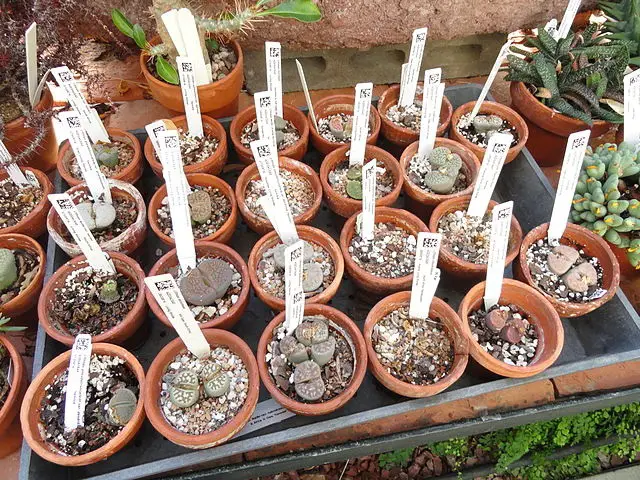
Lithops aucampiae
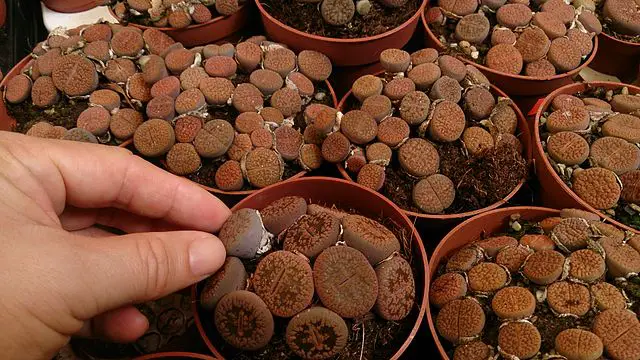
Lithops aucampiae is known for its yellow flowers, a distinct feature among the predominantly white-flowering Lithops species. The plant itself typically presents a grey or brownish top with darker variegated markings, resembling the rocks of its native environment. It’s one of the larger Lithops species and is particularly adaptable to cultivation. The patterns on its surface can vary significantly, adding to its appeal among collectors.
Lithops fulviceps

The Lithops fulviceps boasts an attractive orange-brown color, which stands out in any succulent collection. Its surface texture tends to be rough, creating an intriguing visual effect. The deep fissure at the top, a common characteristic in Lithops, is especially pronounced in this species. This variety thrives under bright light, which intensifies its unique coloration, making it a popular choice for enthusiasts seeking vibrant Lithops.
Lithops hookeri

Lithops hookeri displays a wide color range, including shades of green, brown, and occasionally pinkish tones. It’s particularly noted for its intricate, web-like patterns on the leaf surfaces. These patterns provide excellent camouflage in its natural habitat, blending seamlessly with the surrounding gravel. Lithops hookeri is adaptable to various growing conditions and can be a forgiving choice for beginners.
Lithops lesliei
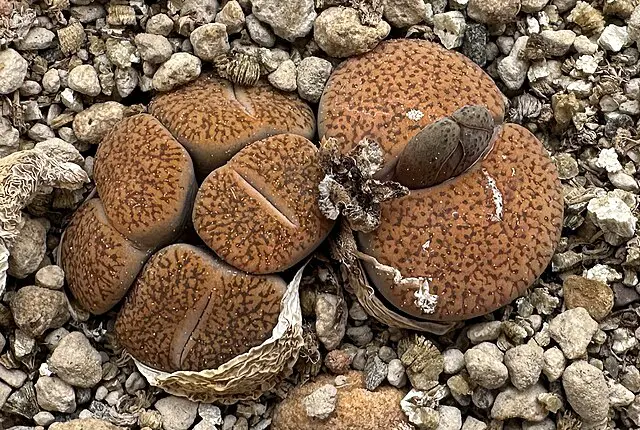
Commonly found in cultivation, Lithops lesliei is known for its remarkable resemblance to brain coral due to its intricate surface patterns. The coloration varies from green to brown, often with hints of yellow or red. This species tends to clump, forming groups of leaf pairs, and is known for its relatively larger and more prominent flowers. Lithops lesliei is an excellent choice for both novice and experienced succulent growers.
Lithops localis
Lithops localis is a rarer species in the Lithops family, prized for its unique beauty. It typically features a smooth, greyish top surface, distinguishing it from its more textured relatives. Due to its rarity and distinct appearance, Lithops localis is highly sought after by collectors. It requires similar care to other Lithops species but may be less forgiving of overwatering.
Lithops olivacea
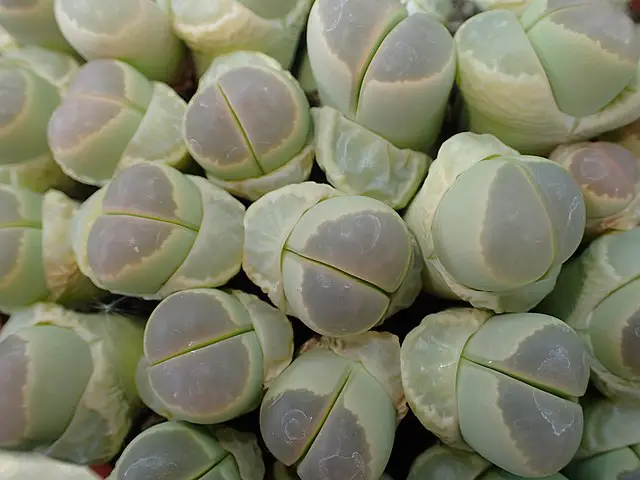
The Lithops olivacea stands out with its distinctive olive-green coloration. This species often has a smoother surface compared to other Lithops and is valued for its subtle and elegant appearance. Lithops olivacea prefers bright, indirect light, which highlights its olive tones. It’s a charming addition to a succulent collection, offering a different palette of colors compared to the more common brown and grey varieties.
Each of these Lithops types offers a unique glimpse into the diversity and adaptability of these fascinating “Living Stones.” Whether you’re drawn to the vibrant colors of Lithops fulviceps or the rare elegance of Lithops localis, there’s a Lithops variety to suit every preference and cultivation skill level.
Optimal Growing Conditions
- Lighting: Lithops thrive in bright light with some direct sun. However, too much direct sunlight can scorch their leaves. A south-facing window or a spot with filtered sunlight is ideal.
- Temperature: These plants prefer warm temperatures but require cooler conditions during their dormancy in the winter. A temperature range of 65-80°F (18-27°C) during the growing season and 50-60°F (10-15°C) in the dormant period is beneficial.
- Humidity: Low to moderate humidity levels are suitable for Lithops. High humidity can increase the risk of rot, especially if the soil is moist.
Lithops Soil
For Lithops, soil isn’t just a medium but a lifeline. These plants thrive in a well-draining mix, typically a blend of a cactus or succulent potting mix with added elements like coarse sand, perlite, or pumice. This mix ensures excess water drains quickly, mimicking the dry conditions of their natural habitat. Organic material is minimal in their preferred soil, as their native grounds are not rich in such matter. Keeping the soil slightly acidic to neutral, within a pH range of 5.5 to 7.5, is also crucial for their growth.
Potting
The choice of pot for Lithops is as critical as the soil. Terracotta or clay pots are preferred for their porous nature, which aids in moisture regulation and air flow. However, plastic pots with sufficient drainage holes can also serve well. Lithops’ shallow root system dictates the need for a not-too-deep pot. The primary rule here is ensuring excellent drainage – the presence of drainage holes at the bottom of the pot is non-negotiable to prevent water accumulation and root rot.
Repotting Lithops
Repotting Lithops, a task ideally undertaken during their growing season in spring or early summer, requires a gentle touch. These plants are sensitive and can be easily damaged. Carefully removing the old soil and easing them into their new home without stressing the roots is key. After repotting, it’s advisable to hold off watering for about a week to let the plant adjust and any minor root injuries to heal. This pause reduces the risk of root rot significantly. Post-repotting, placing Lithops in a bright area with indirect sunlight and gradually reintroducing watering ensures a smooth transition.
Lithops Propagation
Propagation of Lithops, the intriguing ‘Living Stones’, is a fascinating process, offering a deep dive into the replication of these unique succulents. In this guide, we’ll explore the techniques of propagating Lithops, revealing how patience and careful attention can lead to the successful growth of new plants.
Lithops can be propagated in two primary ways: from seeds and through division. Each method has its nuances and requires a specific approach to ensure successful growth.
Propagation Lithops from Seeds
- Sowing the Seeds: Begin by scattering the tiny Lithops seeds over a well-draining soil mix, similar to the one used for adult plants. The key is to lightly cover the seeds with a thin layer of sand or fine soil to protect them while allowing light to reach them.
- Creating the Right Environment: Lithops seeds need a warm, moist environment to germinate. Covering the pot with a clear plastic wrap or glass pane helps maintain the necessary humidity and temperature. It’s crucial to keep the soil consistently moist but not waterlogged during this period.
- Germination and Growth: With proper care, seeds usually germinate within a few weeks. Once the seedlings appear, gradually expose them to more light and less humidity, mimicking their natural growing conditions. This gradual transition is vital for their development.
Propagation through Division
- Timing is Everything: The best time to divide Lithops is when repotting, ideally during their active growing season. Look for clusters where the plant naturally forms divisions.
- Gentle Separation: Carefully separate the clusters, ensuring each division has its own root system. It’s important to handle them delicately to minimize damage.
- Replanting: Plant each division in its own pot, using the same well-draining soil mix as for mature Lithops. Allow the divisions to settle and heal for a few days before watering gently.
Aftercare for Propagated Lithops
- Light Requirements: Young Lithops, whether grown from seeds or divisions, require bright but indirect light. Direct sunlight can be harsh on their delicate forms.
- Watering Practices: Overwatering is the biggest threat to young Lithops. Water sparingly, allowing the soil to dry out completely between waterings. This encourages the development of strong, healthy root systems.
- Patience is Key: Lithops grow slowly, and it can take several years for seedlings to develop into fully formed plants. Patience and careful observation of their needs are essential.
Lithops Watering Schedule
| Season | Months | Watering Instructions |
|---|---|---|
| Spring | March – May | Begin light watering as new leaves form. Increase frequency slightly towards late spring. |
| Summer | June – August | Reduce watering in early summer. Minimize or stop entirely during peak summer heat. |
| Fall | September – November | Resume light watering as temperatures cool and new growth occurs. Maintain steady, light watering. |
| Winter | December – February | Water sparingly, if at all. Lithops are in full dormancy. |
Key Notes:
- Always allow the soil to dry completely between waterings.
- Adjust watering based on the specific conditions of your environment (humidity, indoor temperature, etc.).
- Less is more – overwatering is a common cause of Lithops issues.
This structured schedule should provide a clearer, at-a-glance reference for Lithops watering throughout the year.
Pest and Disease Management
Common pests include mealybugs and aphids. Regular inspection and prompt treatment with appropriate insecticides or natural remedies like neem oil can manage these pests. Over-watering can lead to fungal infections, so it’s crucial to maintain a dry environment.
Common Lithop Issues
- Splitting or Cracking: This can be a natural process of leaf replacement. However, if excessive, it might indicate over-watering.
- Shriveling: While some shriveling is normal during the dormant period, excessive shriveling could indicate underwatering or nutrient deficiency.
- Discoloration: Pale leaves might suggest a lack of sunlight, while red or brown leaves could be a sign of sunburn or stress.
Lithops, with their unique appearance and intriguing growth patterns, are a delightful challenge for succulent enthusiasts. Understanding and replicating their natural habitat’s conditions is key to their care. By mastering the art of Lithops cultivation, one can enjoy the fascinating lifecycle and beautiful blooms of these living stones.


